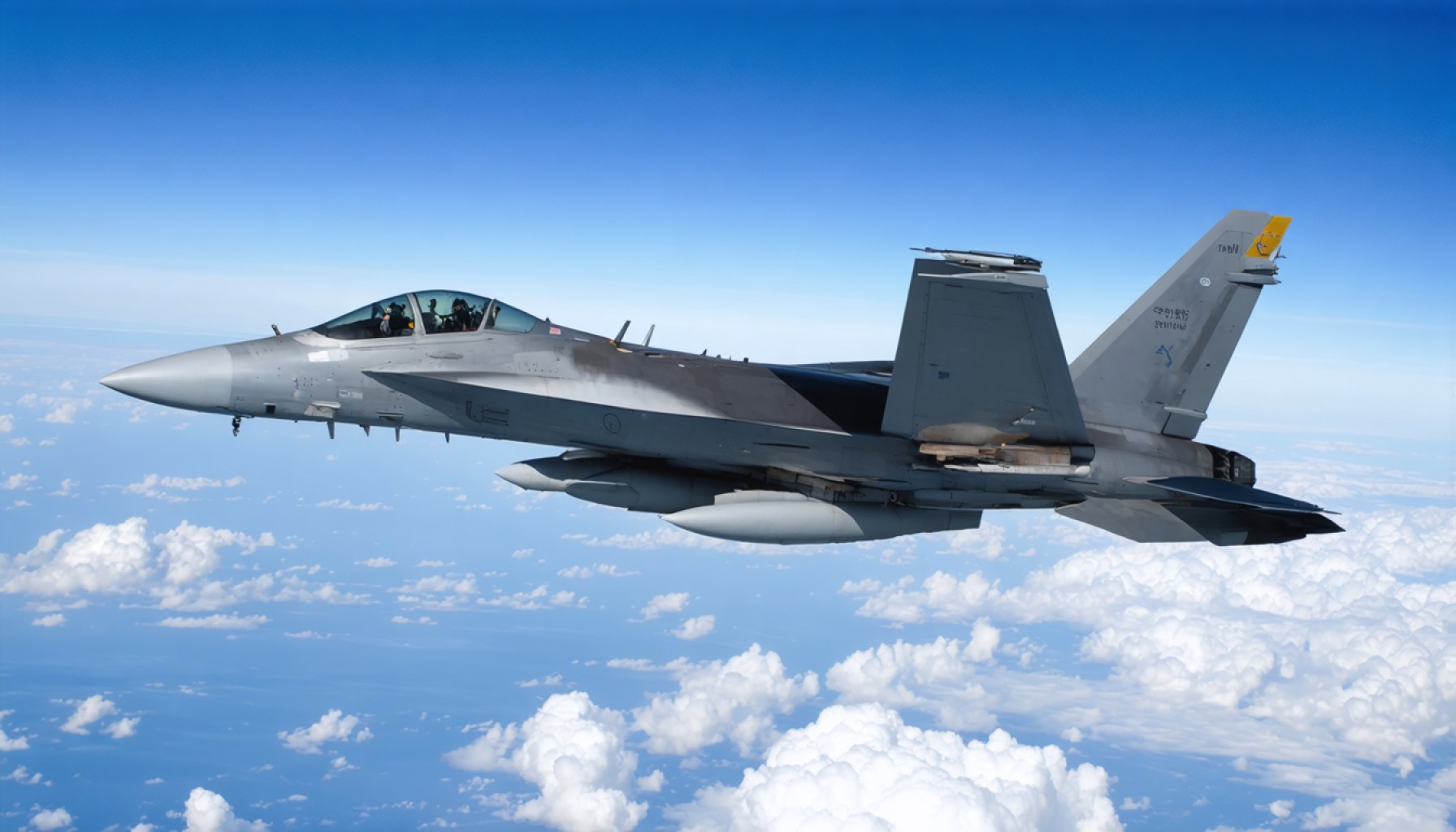- The military aircraft industry is projected to grow from USD 113.4 million in 2023 to USD 196.52 million by 2032, driven by technological advancements and geopolitical tensions.
- Key companies like Lockheed Martin, Boeing, Airbus, and BAE Systems are leading innovation, emphasizing stealth, aerodynamics, and technological integration.
- Global regions, notably North America and Asia-Pacific, are actively contributing to innovations in military and commercial aviation sectors.
- Technologies such as artificial intelligence, hypersonic propulsion, and cybersecurity are becoming integral to next-generation aircraft designs.
- Analytical models like Porter’s Five Forces and PESTLE Analysis envisage threats as opportunities, highlighting the adaptability and resilience of the market.
- The evolution in aircraft technology is reshaping defense strategies, impacting training, deployment, and combat doctrines.
- The market reflects a broader narrative of relentless technological advancement and human ingenuity in shaping future aerospace dynamics.
Amidst advancing technologies and rising geopolitical tensions, the military aircraft industry is on a dynamic trajectory, poised to skyrocket from a valuation of USD 113.4 million in 2023 to a staggering USD 196.52 million by 2032. This evolution, echoing across the tarmacs of defense departments worldwide, promises an enthralling journey for aerospace enthusiasts and defense strategists alike.
As military aircraft bodies glide ominously above us, they bring with them a glimpse of the future—a future molded by rapid innovation and strategic foresight. Central to this evolution are technological powerhouses like Lockheed Martin and The Boeing Company from the United States, who stand as sentinels at the forefront of this exhilarating voyage. Companies like Airbus and BAE Systems, meanwhile, weave the European precision into the fabric of their designs. From the stealth realms of Northrop Grumman to the aerodynamic artistry of Dassault Aviation, these titans craft machines that transform the very nature of aerial combat and surveillance.
Regions across the globe, from the buzzing aerospace hubs of North America to the rising ingénues of Asia-Pacific, exhibit an insatiable appetite for these airborne innovations. Firms in these areas are not merely responding to the clarion call of defense but also looking to reshape commercial travel technologies, promising more fuel-efficient and technologically advanced aircraft. With each launch and deployment, new innovations usher a cascade of demand—each jet, each drone stretching the boundaries of what is possible in the skies above us.
This burgeoning market thrives on the interplay of complex forces dissected through the analytical lens of business matrices such as Porter’s Five Forces and PESTLE Analysis. Here, threats become opportunities, and entrenched challenges morph into catalysts for sublime advancements. Indeed, the resilience of the military aircraft market lies in its adeptness to turn barricades into launchpads.
However, it’s not just about the headline-grabbing figures and growth percentages. It’s also about redefining defense strategies to incorporate next-generation technologies—think artificial intelligence, hypersonic propulsion, and cybersecurity measures woven seamlessly into airframes both sleek and robust. As the machines themselves evolve, the very nature of training, deployment, and combat operations are set to shift, heralding new doctrines of aerial warfare.
In essence, the vibrant symphony of the military aircraft market underscores a pivotal truth: innovation is the ultimate arbiter of success. The compelling growth narrative intertwines with the unrelenting quest for technological excellence, ensuring that the skies of tomorrow will remain a thrilling theater of human ingenuity and strategic prowess. Whether actively engaged in defense sectors or merely awe-inspired spectators, we can all look toward the horizon where these aircraft silhouette the dawn of a new era.
Military Aircraft Industry Skyrockets: What You Need to Know About the Future of Aerial Defense
Introduction
The military aircraft industry is undergoing a monumental transformation, surging from a valuation of USD 113.4 million in 2023 to an expected USD 196.52 million by 2032. This leap is driven by technological innovation, geopolitics, and strategic defense evolutions. As governments and defense organizations invest heavily in new technologies, firms such as Lockheed Martin, Boeing, Airbus, and BAE Systems are at the forefront of this fascinating journey. Let’s delve deeper into the future implications of this growth and explore trends, technological advancements, potential roadblocks, and strategic opportunities that define this dynamic sector.
Key Technological Advancements
1. Stealth Technology: Pioneered by companies like Northrop Grumman, advancements in stealth technology continue to be a game-changer. Their technologies make aircraft less detectable to radar, providing strategic advantages in combat scenarios.
2. Artificial Intelligence (AI): AI integration optimizes piloting systems and improves decision-making processes during missions. AI-enabled drones and aircraft improve real-time data processing and enhance autonomous capabilities.
3. Hypersonic Propulsion: This technology allows aircraft to travel at speeds greater than Mach 5, significantly enhancing the combat and reconnaissance capabilities of military forces.
4. Cybersecurity in Aerospace: As aircraft systems become more digital, ensuring cybersecurity is crucial. Cutting-edge encryption and secure communication channels are paramount to prevent cyber threats.
5. Sustainability and Fuel Efficiency: Innovations aimed at reducing carbon footprints and improving fuel efficiency are critical, with Europe’s Airbus leading efforts in crafting eco-friendly designs.
Market Trends and Forecasts
– Geopolitical Tensions: Heightened global tensions fuel defense spending, pushing countries to upgrade their aerial arsenals.
– Growing Demand in Asia-Pacific: Nations in this region are rapidly increasing their defense budgets, contributing significantly to market growth. Expect substantial aircraft orders and regional advancements in defense tech.
– Commercial and Defense Sector Overlap: Technological innovations have dual applications, benefiting commercial aviation with improved safety, efficiency, and environmental considerations.
Challenges and Limitations
– High Costs and Development Risks: Developing cutting-edge military aircraft is costly and financially risky, requiring substantial investments and long-term commitments.
– Regulatory Hurdles: Stringent international regulations on aircraft exports and technology sharing can limit market opportunities.
– Competition and Collaborations: Balancing competitive edges while fostering collaborations for technological advancements can be complex.
Actionable Recommendations
– Invest in R&D: Companies should prioritize research and development to stay ahead in innovation and competitive strategy.
– Focus on Cybersecurity: With increasing digitalization, investing in robust cybersecurity measures is crucial to safeguard critical military operations.
– Strengthen Supply Chains: Establishing resilient supply chains can ensure sustainability of production and innovation cycles.
– Adopt a Dual-use Technology Strategy: Leveraging innovations in military tech for commercial applications can provide new growth avenues.
Final Thoughts
The military aircraft industry’s robust trajectory illustrates a relentless pursuit of innovation. As countries bolster their defense systems and aerospace firms push the boundaries of technology, the future holds promise for advanced, efficient, and sustainable aerial solutions. Staying informed and adaptable is essential for stakeholders to navigate this evolving landscape.
For more information and updates on the latest advancements in aviation and aerospace, visit the industry leaders at Airbus and Boeing.







